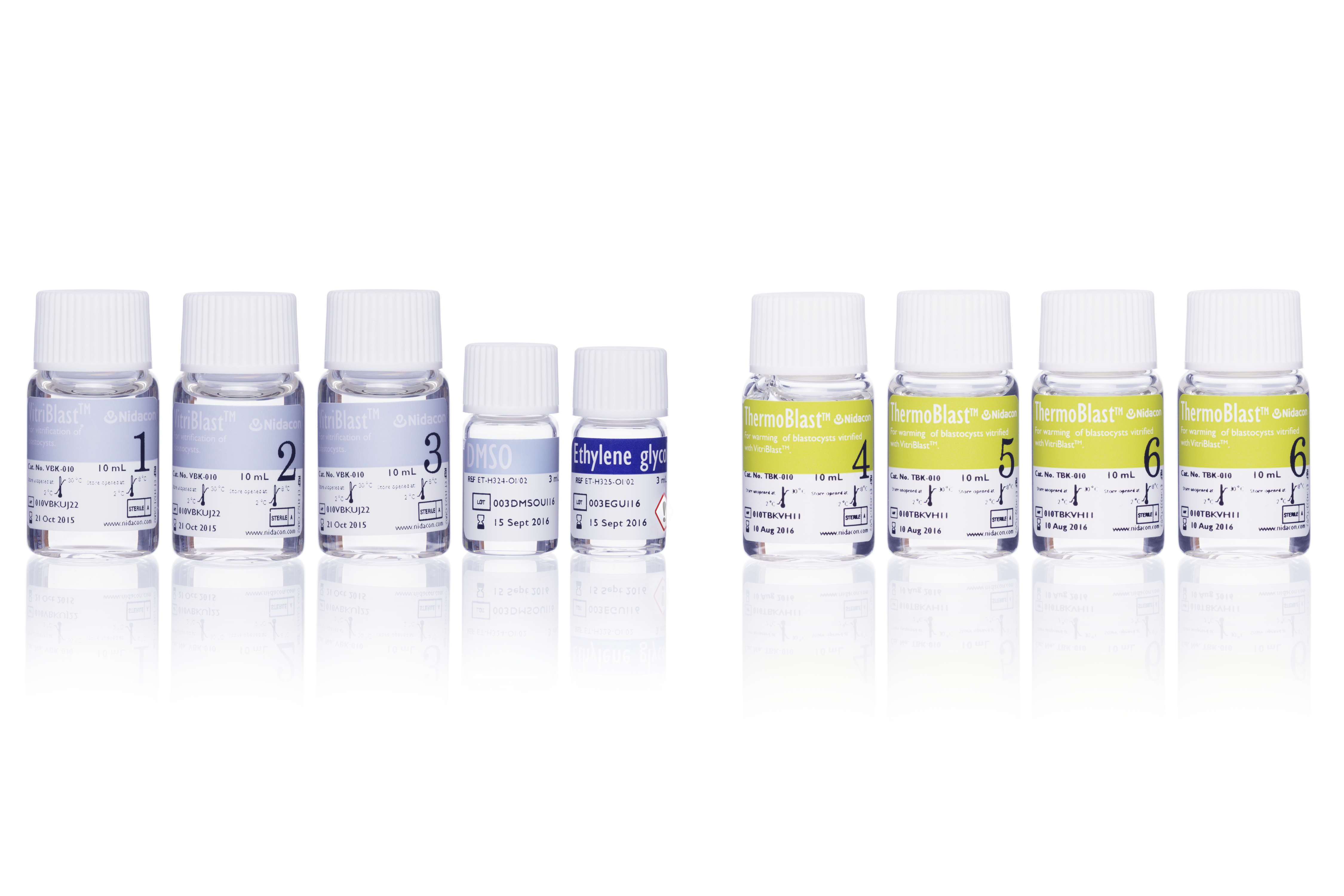ThermoBlast Kit
Based on clinically tested, well established, standard formulations.
4×10 mL (Not available in Europe)
Nidacon’s VitriBlast and ThermoBlast vitrification media are based on well-tested standard formulations (Lane et al) and are both optimised for the vitrification of blastocysts. Since these products have been used in practice for a considerable time and thoroughly tested, Nidacon can provide detailed protocols for vitrifying blastocysts, ensuring the most reliable and secure process possible.
Why Vitrification?
The main challenge when freezing cells is the formation of intracellular ice crystals during both the cooling and rewarming process. These ice crystals have a detrimental effect on cell survival. Vitrification, the extremely rapid freezing of cellular material, makes it possible to freeze cells without ice crystals forming within the cells.
Vitrification produces an amorphous crystalline structure, very homogenous in nature, much like glass and obsidian, which has sharp edges and smooth surfaces (glass transition), and which, like these materials, fractures easily. The cryoprotectants used for vitrification are a combination of Dimethyl Sulfoxide (DMSO), Ethylene Glycol, Sucrose, and Ficoll. Nidacon’s vitrification fluids, VitriBlast for cooling and ThermoBlast for warming/thawing, can both be used with various types of vitrification-devices, but for best results we recommend our own proprietary, closed system device.
Why Nidacon Vitrification?
VitriBlast and ThermoBlast are based on extensive clinical tests and use standardized formulations (Lane et al). Numerous publications have demonstrated the effectiveness of these formulations on both blastocyst survival and pregnancy rates. In addition, follow-up studies have been carried out on live-births, comparing new-births from fresh blastocysts with slow-frozen early cleavage stage embryos and vitrified blastocysts (Wikland M et al. (2010).
Which vitrification device should I use?
One should always use a legally marketed and certified device that is indicated for use in blastocyst vitrification procedures. Use a closed system to prevent the potential risk of viral contamination that comes with using open systems where the sample comes in direct contact with the liquid nitrogen. The device must meet the following cooling standards: minimum 1.800ºC/min (High security straw).
Clinical results
The formulation used in VitriBlast and ThermoBlast has been used at the Fertility Center at Carlanderska Hospital in Gothenburg, Sweden since 2005 with excellent results. Blastocyst survival rates are slightly higher at ca. 5% (84% vs 80%) and pregnancy rate per transfer is much higher (54% vs 37%), when compared to the slow-freezing technique for cleavage stage embryos.
Features
N/A
Components
- Sodium chloride
- Potassium chloride
- Magnesium sulphate
- Potassium dihydrogen phosphate
- Sodium bicarbonate
- hSA (human Serum Albumin)
- Purified water
- Glucose
- Calcium lactate
- Sodium pyruvate
- EDTA
- HEPES
- Sucrose
Performance Characteristics
- pH: 7.20-7.50
- Endotoxin levels: <0.5 EU/mL.
- MEA: Re-expanded blastocysts after exposure >80%.
- Bottles and screw caps are M.E.A. tested.
Storage and Stability
- Store between 2 and 30°C and avoid temperatures above or below these values. VitriBlast has a shelf-life of 12 months from date of production when stored under these conditions. The expiry date is shown on both bottles and cartons.
- Open and close bottles under sterile conditions. After opening, store between 2 and 8°C when not in use. The shelf-life given on the product label applies only when the product is stored according to manufacturer’s recommendations.
- No antibiotics, unstable additives, or preservatives have been added to VitriBlast or ThermoBlast by the manufacturer.
Precautions and warnings
- Use aseptic procedures at all times.
- Do not use any vial or solution that appears cloudy or shows evidence of particulate matter.
- VitriBlast contains DMSO which is a highly penetrative substance. A material safety data sheet is available from the distributor or manufacturer (see nidacon.com).
- VitriBlast contains Ethylene glycol which is toxic when ingested.
- A Closed Vitrification system is mandatory in USA.
- Federal Law (USA) restricts this device to sale by or on the order of a physician.
- Please check for regulatory compliance governing the use of ART products in your country.
General recommendations
N/A
Documents
References
Prediction of live birth in frozen-thawed single blastocyst transfer cycles by pre-freeze and post-thaw morphology.
Ahlström A1, Westin C, Wikland M, Hardarson T., (2013)
Human Reproduction, Vol.28, No.5 pp. 1199–1209
Vitrification of mouse and human blastocysts using a novel cryoloop container-less technique.
Lane M et al, (1999)
Fertility and Sterility., Vol 72, No 6, pp1073-1078
Vitrification of human blastocysts using cryoloops: Clinical outcome of 223 cycles.
Mukaida T et al. (2003)
Hum Reprod., Vol. 18, No. 2, pp384-391
Perinatal outcome of blastocyst transfer with vitrification using cryoloop: A 4 year follow-up study.
Takahashi K et al. (2005)
Fertil Steril., Vol. 84, No. 1, 88-92
Obstetric outcome of children born after transfer of vitrified blastocysts
Wikland M et al. (2010).
Human Reproduction, Vol.00, No.0 pp. 1–9
Vitrification and warming human blastocysts by use of a laser to artificially induce blastocyst collapse prior to vitrification.
T. Hardarson et al. (2006)
Acta Obstet Gynecol Scand. 86 pp119-120
FAQ
Can Blastocysts cultured in any culture media be vitrified with your kits?
VitriBlast /ThermoBlast kit can be used to freeze blastocysts that have been cultured in any culture media.

